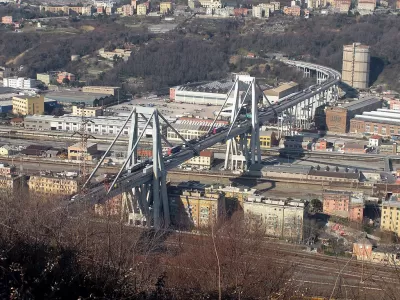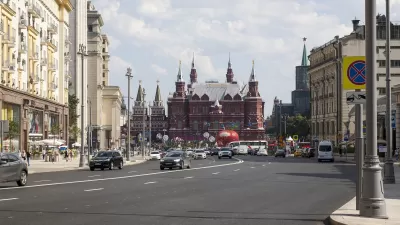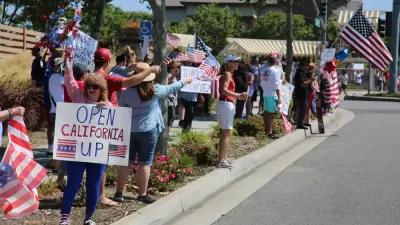At least 39 people died when the Ponte Morandi bridge collapsed in Genoa, Italy during a storm on Tuesday. The cable-stayed bridge is part of a viaduct on the A10 toll road that goes to France, operated and maintained by Autostrada per l'Italia.

"A vast span of the Morandi bridge caved in during a heavy rainstorm in the northern port city [of Genoa], sending about 35 cars and several trucks plunging 45 metres (150ft) on to railway tracks below," according to The Guardian.
"Italian political leaders have been quick to point the finger at [Autostrade per l’Italia,] the private company responsible for maintaining the Ponte Morandi Bridge," which opened in 1967 with the Autostrada A10, reports Amy Held for NPR. The cable-stayed bridge is named after designer Riccardo Morandi.
Deputy Prime Minister Matteo Salvini said he would work to "identify the culprits of this disaster, which will not go unpunished." He tweeted that those responsible will "pay dearly."
The company, a "leading European Concessionaire for toll motorway construction and management," according to owner Atlantia Group, defended its record of maintaining the 51-year-old bridge.
From 2012 to 2017, "the company's investments in safety, maintenance and upgrading of the network have exceeded 1 billion euros [$1.134 billion] a year," Autostrade said in a statement emailed to NPR. The company added that its safety investments have resulted in fewer deaths and accidents.
Officials say it's too early to explain why the bridge collapsed during the powerful storm. The New York Times account of the incident helps to put the government's response into context.
"The calamity presented a serious test of Italy’s new government, a coalition of populist parties that was formed only months ago, report Gaia Pianigiani, Elisabetta Povoledo and Richard Pérez-Peña on Aug. 14. "They rode to power on a wave of anti-establishment anger, but the coalition is led by people who had little to no experience governing, and now must demonstrate that they can manage a crisis and the scrutiny that comes with it."
"The Morandi bridge has been riddled with structural problems since its construction in 1967, which has led to expensive maintenance and repeated criticism from engineering experts," report The Guardian's Angela Giuffrida and Lorenzo Tondo.
On Tuesday the specialist engineering website Ingegneri.info published a piece that highlighted longstanding concerns over the bridge, calling it “a tragedy waiting to happen”.
"Restructuring work on the bridge was carried out in 2016," reported Giuffrida on Tuesday. "The highway operator said work to strengthen the road foundations of the bridge was being carried out at the time of the collapse, and the bridge was constantly monitored."
Sylvia Poggioli, senior European correspondent for NPR's international desk, also reports on the calamity (audio and transcript). In a separate, 5-minute (audio-only) interview on Wednesday with Here & Now's Robin Young, Poggioli explains that the bridge had exceeded its traffic capacity, the definition making it functionally obsolete but not necessarily structurally deficient.
"Italians pride themselves on repairing and restoring ancient things, and the idea of tearing something down....is not in their mentality," states Poggioli, adding, "this may require some revision."
John Surico also explores reasons for the bridge collapse in an insightful piece for CityLab. "The incident has sparked an urgent debate over the country’s ability to maintain its postwar infrastructure."
FULL STORY: Death Toll In Genoa Bridge Collapse Rises To 39

Maui's Vacation Rental Debate Turns Ugly
Verbal attacks, misinformation campaigns and fistfights plague a high-stakes debate to convert thousands of vacation rentals into long-term housing.

Planetizen Federal Action Tracker
A weekly monitor of how Trump’s orders and actions are impacting planners and planning in America.

Chicago’s Ghost Rails
Just beneath the surface of the modern city lie the remnants of its expansive early 20th-century streetcar system.

Bend, Oregon Zoning Reforms Prioritize Small-Scale Housing
The city altered its zoning code to allow multi-family housing and eliminated parking mandates citywide.

Amtrak Cutting Jobs, Funding to High-Speed Rail
The agency plans to cut 10 percent of its workforce and has confirmed it will not fund new high-speed rail projects.

LA Denies Basic Services to Unhoused Residents
The city has repeatedly failed to respond to requests for trash pickup at encampment sites, and eliminated a program that provided mobile showers and toilets.
Urban Design for Planners 1: Software Tools
This six-course series explores essential urban design concepts using open source software and equips planners with the tools they need to participate fully in the urban design process.
Planning for Universal Design
Learn the tools for implementing Universal Design in planning regulations.
planning NEXT
Appalachian Highlands Housing Partners
Mpact (founded as Rail~Volution)
City of Camden Redevelopment Agency
City of Astoria
City of Portland
City of Laramie





























